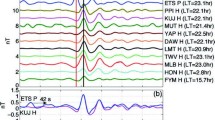Abstract
We considered wave disturbances of the Pi2 type geomagnetic field (periods of 1–2 min) recorded simultaneously by magnetometers at low-latitude stations in Africa and on low-orbit SWARM satellites both during the beginning of a substorm and in non-substorm periods. At night, Pi2 waves in the upper ionosphere and on Earth are almost identical in amplitude and in phase. These waves on the satellite mainly manifest themselves in longitudinal (along the geomagnetic field) and radial magnetic components. A comparison of the observational results with the model of the interaction of MHD waves with the ionosphere–atmosphere–Earth system shows that night low-latitude Pi2 signals are generated by magnetospheric fast magnetosonic waves propagating to the Earth through the opacity region. The results of analytical estimates and numerical simulations are consistent with the properties of Pi2 signals recorded in the upper ionosphere and on Earth.







Similar content being viewed by others
REFERENCES
Landau, L.D. and Lifshits, E.M., Teoreticheskaya fizika (Theoretical Physics), vol. 8: Elektrodinamika sploshnykh sred (Electrodynamics of Continuous Media), Moscow: Nauka, 1987.
Fedorov, E.N. and Pilipenko, V.A., Electromagnetic sounding of planets from a low-orbiting probe, Cosmic Res., 2014, vol. 52, no. 1, pp. 46–51.
Alperovich, L.S. and Fedorov, E.N., Hydromagnetic Waves in the Magnetosphere and the Ionosphere, Springer, 2007.
Balasis, G., Papadimitriou, C., Zesta, E., and Pilipenko, V., Monitoring ULF waves from low Earth orbit satellites, Waves, Particles, and Storms in Geospace, Oxford University Press, 2016, pp. 148–169.
Cuturrufo, F., Pilipenko, V., Heilig, B., Stepanova, M., Luhr, H., Vega, P., and Yoshikawa, A., Near-equatorial Pi2 and Pc3 waves observed by CHAMP and on SAMBA/MAGDAS stations, Adv. Space Res., 2015, vol. 55, pp. 1180–1189.
Han, D.-S., Iyemori, T., Nose, M., et al., A comparative analysis of low latitude Pi2 pulsations observed by Ørsted and ground stations, J. Geophys. Res., 2004, vol. 109, A10209. https://doi.org/10.1029/2004JA010576
Hartinger, M.D., Zou, S., Takahashi, K., et al., Nightside Pi2 wave properties during an extended period with stable plasmapause location and variable geomagnetic activity, J. Geophys. Res., 2017, vol. 122, no. 12, pp. 12006–12018. https://doi.org/10.1002/2017JA024708
Keiling, A. and Takahashi, K., Review of Pi2 models, Space Sci. Rev., 2011, vol. 161, pp. 63–148.
Kim, K.-H., Takahashi, K., Lee, D.-H., Sutcliffe, P.R., and Yumoto, K., Pi2 pulsations associated with poleward boundary intensifications during the absence of substorms, J. Geophys. Res., 2005, vol. 110, A01217. https://doi.org/10.1029/2004JA010780
Lee, D.H., On the generation mechanism of Pi2 pulsations in the magnetosphere, Geophys. Res. Lett., 1998, vol. 25, pp. 583–586.
Lysak, R.L., Song, Y., Sciffer, M.D., and Waters, C.L., Propagation of Pi2 pulsations in a dipole model of the magnetosphere, J. Geophys. Res., 2015, vol. 120, pp. 355–367.
Martines-Bedenko, V.A., Pilipenko, V.A., Engebretson, M.J., and Moldwin, M.B., Time–spatial correspondence between Pi2 wave power and ultra-violet aurora bursts, Russ. J. Earth Sci., 2017, vol. 17, pp. 1–14. https://doi.org/10.2205/2017ES000606
Pilipenko, V. and Heilig, B., ULF waves and transients in the topside ionosphere, Low-Frequency Waves in Space Plasmas, 2016, Keiling, A., Lee, D.H., and Nakariakov, V., Eds., Wiley/Am. Geophys. Union, 2016, pp. 15–29.
Pilipenko, V., Fedorov, E., Heilig, B., and Engebretson, M.J., Structure of ULF Pc3 waves at low altitudes, J. Geophys. Res., 2008, vol. 113, A11208. https://doi.org/10.1029/2008JA013243
Shinohara, M., Yumoto, K., Yoshikawa, A., et al., Wave characteristics of daytime and nighttime Pi2 pulsations at the equatorial and low latitudes, Geophys. Res. Lett., 1997, vol. 24, pp. 2279–2282.
Sutcliffe, P.R. and Luhr, H., A comparison of Pi2 pulsations observed by CHAMP in low earth orbit and on the ground at low latitudes, Geophys. Res. Lett., 2003, vol. 30, 2105. https://doi.org/10.1029/2003GL018270
Takahashi, K., Ohtani, S., and Yumoto, K., AMPTE CCE observations of Pi2 pulsations in the inner magnetosphere, Geophys. Res. Lett., 1992, vol. 19, pp. 1447–1450.
Teramoto, M., Nishitani, N., Pilipenko, V., et al., Pi2 pulsation simultaneously observed in the E and F region ionosphere with the SuperDARN Hokkaido radar, J. Geophys. Res., 2014, vol. 119, pp. 3444–3462.
Waters, C.L., Lysak, R.L., and Sciffer, M.D., On the coupling of fast and shear Alfvén wave modes by the ionospheric hall conductance, Earth Planets Space, 2013, vol. 65, pp. 385–396.
Yeoman, T.K. and Orr, D., Phase and spectral power of mid-latitude Pi2 pulsations: Evidence for a plasmaspheric cavity resonance, Planet. Space Sci., 1989, vol. 37, pp. 1367–1383.
ACKNOWLEDGMENTS
We thank the SWARM team for the provided data (https://earth.esa.int/web/guest/swarm). The coordinates of the geomagnetic (dip) equator are prepared by the International Data Center (Kyoto) (http://wdc.kugi.kyoto-u.ac.jp/ ~nose/kml). We thank the reviewer for helpful comments.
Funding
This work was supported by a grant of the Russian Science Foundation (agreement No. 16-17-00121).
Author information
Authors and Affiliations
Corresponding author
Additional information
Translated by N. Topchiev
Rights and permissions
About this article
Cite this article
Martines-Bedenko, V.A., Pilipenko, V.A., Fedorov, E.N. et al. Low-Latitude Pi2 Waves according to Observations on SWARM Satellites and Ground Stations. Cosmic Res 58, 1–11 (2020). https://doi.org/10.1134/S0010952520010050
Received:
Revised:
Accepted:
Published:
Issue Date:
DOI: https://doi.org/10.1134/S0010952520010050



